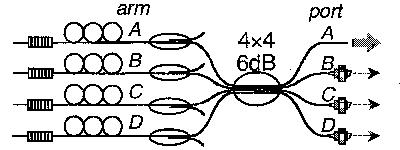File:CoherentAddition.jpg
Example of the coherent addition (coherent combining) of 4 fiber lasers.
There are 100% reflection mirrors (Bragg reflectors) at the left hand side.
There are coiled laser amplifiers which can be realized as single-mode double-clad fibers; which are, perhaps, coiled. There is coherent coupler, which provides the splitting of modes of lases. Such a splitter has so many outputs, as inputs. Most of outputs are cleaved providing almost zero reflectivity, and only one provides significant feedback. This channed determines the modes with minimal losses. Such modes are common for all lasers, providing the coherent addition of lasers.
This figure has an analogy at http://en.wikipedia.org/wiki/File:CoherentAddition.jpg
The free use is allowed, the attribution is required.
Description from http://en.wikipedia.org/wiki/Coherent_addition is below
Coherent addition
Usually, the term coherent addition applies to fiber lasers. As the ability of pumping and/or cooling of a single laser is saturated, several similar lasers can be forced to oscillate in phase with common coupler. The coherent addition was demonstrated in power scaling of Raman lasers [1].
Limits of coherent addition
The addition of lasers reduces the number of longitudinal modes in the output beam; the more lasers are combined, the smaller is the number of longitudinal modes in the output. The simple estimates show that the number of output modes reduces exponentially with number of lasers combined. Of order of eight lasers can be combined in such a way.[2] The future increase of number of combined lasers requires the exponential growth of the spectral bandwidth of gain and/or length of partial lasers. The same conclusion can be made also on the base of more detailed simulations. [3] Practically, the combination of more than ten lasers in such a way should be difficult if at all.
References
- ↑ A. Shirakawa, T. Saitou, T. Sekiguchi and K. Ueda: "Coherent addition of fiber lasers by use of a fiber coupler" Optics Express 10 (2002) 1167–1172
- ↑ D. Kouznetsov, J.F. Bisson. A. Shirakawa, K.Ueda "Limits of Coherent Addition of Lasers: Simple Estimate" Optical Review Vol. 12, No. 6, 445–447 (2005). (Also [1].)
- ↑ A.E.Siegman. Resonant modes of linearly coupled multiple fiber laser structures. Preprint of the Stanford University, 2005, 25 pages; http://www.stanford.edu/~siegman/coupled_fiber_modes.pdf
File history
Click on a date/time to view the file as it appeared at that time.
| Date/Time | Thumbnail | Dimensions | User | Comment | |
|---|---|---|---|---|---|
| current | 17:50, 20 June 2013 | 400 × 150 (16 KB) | Maintenance script (talk | contribs) | Importing image file |
- You cannot overwrite this file.
File usage
The following 2 pages link to this file:

